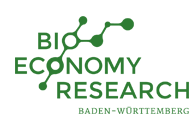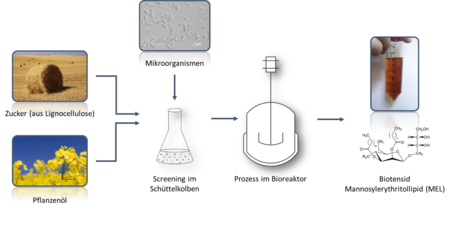Enzymatic and microbiological synthesis of biosurfactants based on lignocellulose substrates
Encymatic synthesis: Biosurfactants are based on natural compounds and can be manufactured by chemical, enzymatic, or microbial processes. There is a broad range of different cosmetic, pharmaceutical, food, and personal care products that could be manufactured using enzymatically synthesized biosurfactants.
In this project it shall be evaluated whether the enzymatic synthesis of novel, tailor-made biosurfactants based on different lignocellulose fractions is possible. These biosurfactants would be an ecological and economic alternative to previous products that are based on petrochemicals or renewable resources which compete with food.
To establish our synthesis reactions and analytical methods for biosurfactant production commercially available sugars, sugar alcohols, fatty acids or fatty acid vinyl esters will be used. Later in this project, different lignocellulose fractions provided by cooperation partners in the research program will be tested. These fractions can contain, depending on the decomposition process, various sugars, sugar alcohols and acids, terpenes, or aromatic compounds. Tall oil and oil from microalgae production can be used too.
Synthesized biosurfactants will be characterized by thin layer chromatography, mass determination, and NMR as well as through their surfactant properties (cmc, HLB, etc.)
Mikrobial synthesis: Most microbial biosurfactants are produced with commercial glucose and first generation substrates such as molasses, corn syrup, or vegetable oils. Some disadvantages of these substrates are the competition with food demand and animal feed and the use of extended agricultural land. In contrast, lignocellulose substrates have garnered special attention at scientific and industrial levels because lignocellulose is one of the most abundant renewable carbon sources and has a comparably low price.
The main objective of this project was to develop a fermentation process for the microbial synthesis of biosurfactants based on lignocellulose substrates and plant oils that could be transferred into pilot and production scale.
Initially, the suitability of different plant oils and lignocellulose hydrolysates was evaluated as substrates for the biosynthesis of the biosurfactant mannosylerythritol lipid (MEL) using fungi of the family of Ustilaginaceae. It was shown that the different microorganisms produced different structures and thus properties of the MEL biosurfactants. These microorganisms showed a high substrate tolerance. Both C6- as well as C5-sugars and different plant oils were successfully employed for MEL production.
For a selected strain, a detailed study on the regulation of MEL biosynthesis was performed with qPCR. The type and concentration of the nitrogen source showed a major influence on MEL production, where nitrogen limitation proved beneficial. Towards the end, the production process with this strain was transferred to bioreactor scale.
Overall, we could demonstrate a large structural variety of MEL biosurfactants, making them suitable for different applications. The successful transfer into a bioreactor is the base for further establishing the process at industrial scale in the future.
Project title | Enzymatische und Mikrobielle Synthese von maßgeschneiderten Biotensiden auf der Basis von Lignozellulose |
Institutions and research group | Prof. Dr. Christoph Syldatk, Dipl.-Biol. (t.o.) Sascha Siebenhaller Universität Stuttgart, Institut für Grenzflächenverfahrenstechnik und Plasmatechnologie IGVP Dr. Steffen Rupp, Dr. Susanne Zibek, Alexander Beck |


